
Ernest Peter Smith (October 28, 1907 – February 25, 1975) was a Native American artist from the Tonawanda Seneca Nation.[1] Smith painted mostly traditional Seneca myths and stories of daily life in the Seneca village he grew up in. In the 1930s Smith produced a large series of paintings documenting Seneca life, as part of the WPA Indian Art Project.
Early life and career
Ernest Smith was born and raised on the Tonawanda Reservation, a son of Louisa (née Sundown) and Peter S. Smith. He was the youngest of seven children and a member of the Heron Clan. [2][3] In his childhood, Smith began to teach himself how to draw and paint, but he left school before he could graduate to help support his family.
Smith first became known as an artist when anthropologist Arthur C. Parker hired him to be a part of the WPA Indian Arts Project around 1935, which was sponsored by the Rochester Municipal Museum.[4] He joined Jesse Cornplanter and Samford Plummer as the most prolific Haudenosaunee artists who were a part of this anthropological project.[5][6] As part of the project, Smith created a mural at the Rochester Museum and Science Center.[7]
Collections
- National Museum of the American Indian[8]
- Rochester Museum and Science Center[9][10]
- National Anthropological Archives of the Smithsonian Institution[11]
References
- ↑ "The Last O-Nyiah-Gway-Hay | National Museum of the American Indian". americanindian.si.edu.
- ↑ Fenton, William N. (William Nelson); Smith, Ernest; Collamer, Jeanette. "Interviews concerning the paintings of the Seneca artist Ernest Smith". search.amphilsoc.org.
- ↑ Cornelius, Carol. Iroquois Corn in a Culture-Based Curriculum: A Framework for Respectfully Teaching about Cultures. SUNY Press. pp. 164–. ISBN 978-0-7914-9983-2.
- ↑ "Rochester and Native Art in the 1930s – InVisible Culture". ivc.lib.rochester.edu.
- ↑ Stevens, Scott Manning (2020). "Collecting Haudenosaunee Art from the Modern Era". Arts. 9 (2): 55. doi:10.3390/arts9020055.
- ↑ Ortel, Jo (4 December 2013). "Review of "Iroquois Art, Power, and History" by Neal B. Keating". CAA Reviews. doi:10.3202/caa.reviews.2013.132.
- ↑ Eisenstadt, Peter (19 May 2005). The Encyclopedia of New York State. Syracuse University Press. ISBN 978-0-8156-0808-0.
- ↑ "Traditions and Beliefs". blog.nmai.si.edu.
- ↑ "Peace Queen". rmsc.org.
- ↑ "LibCat - Rochester Museum & Science Center". libcat.rmsc.org.
- ↑ "MS 4398 Materials relating to The Iroquois Eagle Dance, an Offshoot of the Calumet Dance, Bureau of American Ethnology Bulletin 156 · SOVA". sova.si.edu.